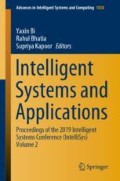Abstract
Due to the development of both computational power of mobile devices and display technology mixed reality solutions have become possible. As the entertainment industry has taken the technology eagerly in use, it has also opened several possibilities to develop solutions to enhance and support work processes in industrial and maritime use. In this paper user-testing of a few of these prototypes of mixed reality solutions is presented.
Access this chapter
Tax calculation will be finalised at checkout
Purchases are for personal use only
Notes
- 1.
Mobile Augmented Reality Tool for Marine Industry, https://tech.utu.fi/ar/research/marin/.
- 2.
Mobile Mixed Reality Applications for Professional Use, https://tech.utu.fi/ar/research/marin2/.
- 3.
- 4.
References
Ranasinghe, N., Karunanayaka, K., Cheok, A.D., Fernando, O.N.N., Nii, H., Gopalakrishnakone, P.: Digital taste and smell communication. In: Proceedings of the 6th International Conference on Body Area Networks (BodyNets 2011). ICST (Institute for Computer Sciences, Social-Informatics and Telecommunications Engineering), ICST, Brussels, Belgium, Belgium, pp. 78–84 (2011) http://dl.acm.org/citation.cfm?id=2318795
Colwell, C., Petrie, H., Kornbrot, D., Hardwick, A., Furner, S.: Haptic virtual reality for blind computer users. In: Proceedings of the Third International ACM Conference on Assistive Technologies (Assets 1998), 92–99. ACM, New York (1998). http://dx.doi.org/10.1145/274497.274515
Ischer, M., Baron, N., Mermoud, C., Cayeux, I., Porcherot, C., Sander, D., Delplanque, S.: How incorporation of scents could enhance immersive virtual experiences. Front. Psychol. 5, 736 (2014). https://doi.org/10.3389/fpsyg.2014.00736
Bujak, K.R., Radu, I., Catrambone, R., MacIntyre, B., Zheng, R., Golubskic, G.: A psychological perspective on augmented reality in the mathematics classroom. Comput. Educ. 68, 536–544 (2013)
Di Serio, Á., Ibáñez, M.B., Kloos, C.D.: Impact of an augmented reality system on students’ motivation for a visual art course. Comput. Educ. 68, 586–596 (2013)
Seppälä, K., Heimo, O.I., Pääkylä, J., Latvala, J., Helle, S., Härkänen, L., Jokela, S., Järvenpää, L., Saukko, F., Viinikkala, L., Mäkilä, T., Lehtonen, T.: Examining user experience in an augmented reality adventure game: case Luostarinmäki handicrafts museum. In: 12th IFIP TC9 Human Choice and Computers Conference – 7th–9th September 2016 (2016)
Heimo, O.I., Kimppa, K.K., Yli-Seppälä, L., Viinikkala, L., Korkalainen, T., Mäkilä, T., Lehtonen, T.: Ethical problems in creating historically representative mixed reality make-belief. In: CEPE/ETHICOMP 2017 Values in Emerging Science and Technology, University of Turin, Italy, 5–8 June 2017 (2017)
Henrysson, A., Ollila, M.: UMAR: ubiquitous mobile augmented reality. In: MUM 2004 Proceedings of the 3rd International Conference on Mobile and Ubiquitous Multimedia, pp. 41–45. ACM, New York ©2004 (2004)
Sakari, L., Helle, S., Korhonen, S., Säntti, T., Heimo, O.I., Forsman, M., Taskinen, M., Lehtonen, T.: Virtual and augmented reality solutions to industrial applications. In: Proceedings of COMPIT 2017 International Conference on Computer Applications and Information Technology in the Maritime Industries, 15–17 May 2017, Cardiff, UK (2017)
Milgram, P., Takemura, H., Utsumi, A., Kishino, F.: Augmented reality: a class of displays on the reality-virtuality continuum (PDF). In: Proceedings of Telemanipulator and Telepresence Technologies, p. 2351(34) (1994)
HTC, Vive. https://www.vive.com/. Accessed 13 Mar 2017
Microsoft, Microsoft HoloLens. https://www.microsoft.com/microsoft-hololens/en-us. Accessed 13 Mar 2017
Oculus, Rift. https://www.oculus.com/rift/. Accessed 13 Mar 2017
Brother, AiRScouter. https://www.brother-usa.com/AiRScouter/. Accessed 13 May 2017
Epson, Moverio Smart Eyewear. https://epson.com/moverio-augmented-reality. Accessed 13 Mar 2017
Vuzix, Vuzix—View the Future. https://www.vuzix.com/. Accessed 13 Mar 2017
Google, Google Cardboard | Experience virtual reality in a simple, fun and affordable way. https://vr.google.com/cardboard/. Accessed 13 Mar 2017
Samsung, GearVR—Powered by Oculus. http://www.samsung.com/global/galaxy/gear-vr/. Accessed 13 Mar 2017
Nurminen, M.I.: People or Computers: Three Ways of Looking at Information Systems. Studentlitteratur, Cartwell Brat Ltd., Lund (1986)
Heimo, O.I., Kimppa, K.K., Nurminen, M.I.: Ethics and the inseparability postulate. In: ETHIComp 2014, Pierre & Marie Curie University, Paris, France, 25th–27th July 2014 (2014)
Heimo, O.I.: Icarus, or the idea toward efficient, economical, and ethical acquirement of critical governmental information systems, Ph.D. thesis, Turku School of Economics, University of Turku 2018 (2018)
Acknowledgment
The research has been carried out during the MARIN2 project (Mobile Mixed Reality Applications for Professional Use) funded by Tekes (The Finnish Funding Agency for Innovation) in collaboration with partners; Defour, Destia, Granlund, Infrakit, Integration House, Lloyd’s Register, Nextfour Group, Meyer Turku, BuildingSMART Finland, Machine Technology Center Turku and Turku Science Park. We would especially like to thank all those participating to this study.
Author information
Authors and Affiliations
Corresponding author
Editor information
Editors and Affiliations
Rights and permissions
Copyright information
© 2020 Springer Nature Switzerland AG
About this paper
Cite this paper
Heimo, O.I., Sakari, L., Säntti, T., Lehtonen, T. (2020). Mixed Reality for Industry? An Empirical User Experience Study. In: Bi, Y., Bhatia, R., Kapoor, S. (eds) Intelligent Systems and Applications. IntelliSys 2019. Advances in Intelligent Systems and Computing, vol 1038. Springer, Cham. https://doi.org/10.1007/978-3-030-29513-4_17
Download citation
DOI: https://doi.org/10.1007/978-3-030-29513-4_17
Published:
Publisher Name: Springer, Cham
Print ISBN: 978-3-030-29512-7
Online ISBN: 978-3-030-29513-4
eBook Packages: Intelligent Technologies and RoboticsIntelligent Technologies and Robotics (R0)

